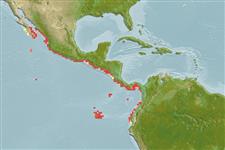Common names from other countries
Klassifizierung / Names
Namen | Synonyme | Catalog of Fishes(Gattung, Arten) | ITIS | CoL | WoRMS | Cloffa
Environment: milieu / climate zone / depth range / distribution range
Ökologie
seewasser riff-verbunden. Tropical; 26°N - 3°S, 113°W - 76°W (Ref. 114953)
Eastern Central Pacfic: Baja California (Mexico) to Ecuador; including the Galapagos Is.
Length at first maturity / Size / Gewicht / Alter
Maturity: Lm 110.0 range ? - ? cm
Max length : 260 cm TL Männchen/unbestimmt; (Ref. 9254)
Inhabit rocky and coral reefs (Ref. 12951); on soft and sandy bottoms. Feeds mainly on mantis shrimps and fishes (Ref. 114953). Ovoviviparous (Ref. 50449). Litters of 1-5 pups; gestation period 10-11 months (Ref. 114953); Caught rarely by the gillnet fisheries operating in shelf waters. Utilized for its meat (Ref.58048).
Exhibit ovoviparity (aplacental viviparity), with embryos feeding initially on yolk, then receiving additional nourishment from the mother by indirect absorption of uterine fluid enriched with mucus, fat or protein through specialised structures (Ref. 50449). Distinct pairing with embrace (Ref. 205). Brood consists of 1-3 neonates and grow to about 40 cm DW in spring-summer (Ref. 38396).
Compagno, L.J.V., 1999. Checklist of living elasmobranchs. p. 471-498. In W.C. Hamlett (ed.) Sharks, skates, and rays: the biology of elasmobranch fishes. Johns Hopkins University Press, Maryland. (Ref. 35766)
IUCN Rote Liste Status (Ref. 130435)
CITES (Ref. 128078)
Not Evaluated
Nutzung durch Menschen
Fischereien: weniger kommerziell
Tools
Zusatzinformationen
Download XML
Internet Quellen
Estimates based on models
Preferred temperature (Ref.
115969): 23.1 - 28.5, mean 27 (based on 40 cells).
Phylogenetic diversity index (Ref.
82804): PD
50 = 0.5039 [Uniqueness, from 0.5 = low to 2.0 = high].
Bayesian length-weight: a=0.00646 (0.00265 - 0.01571), b=3.06 (2.86 - 3.26), in cm Total Length, based on LWR estimates for this (Sub)family-body shape (Ref.
93245).
Trophic level (Ref.
69278): 3.5 ±0.37 se; based on food items.
Widerstandsfähigkeit (Ref.
120179): sehr niedrig, Verdopplung der Population dauert mehr als 14 Jahre. (Fec=1-3).
Fishing Vulnerability (Ref.
59153): Very high vulnerability (90 of 100).
